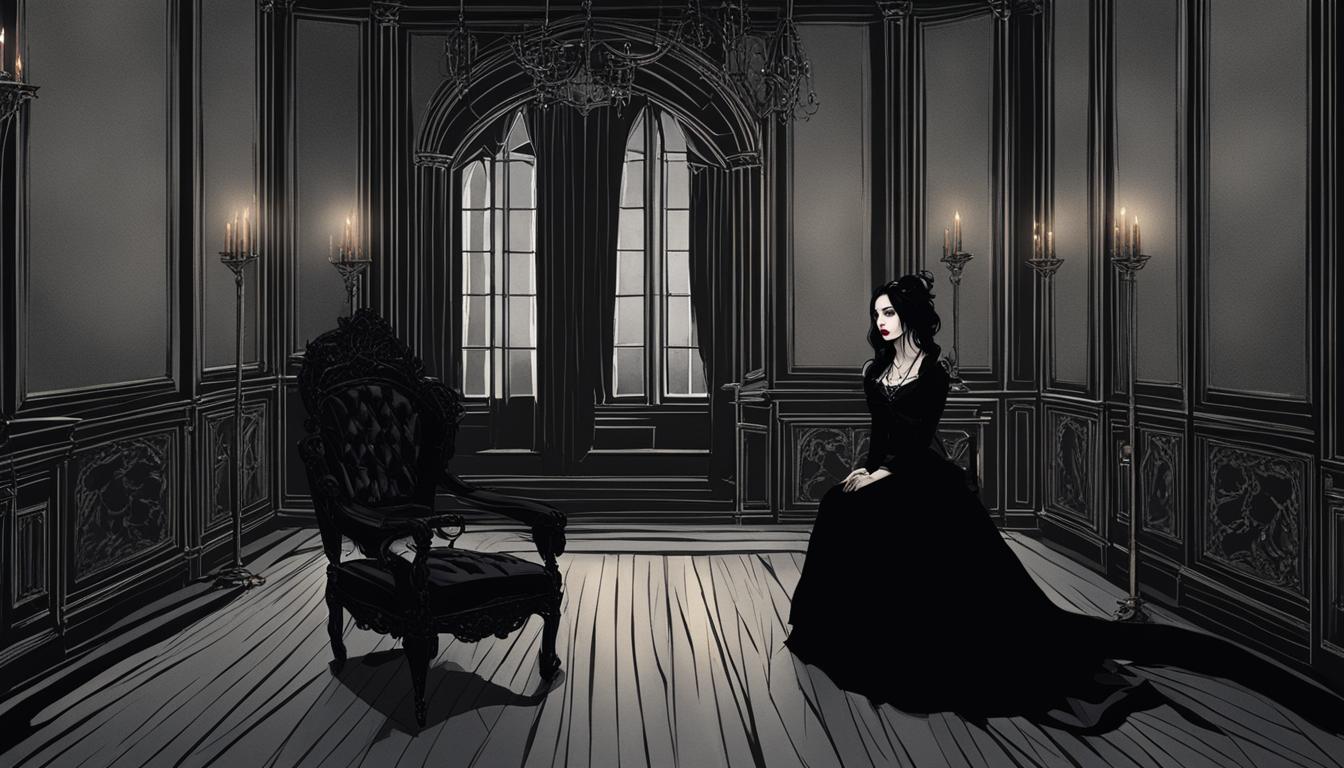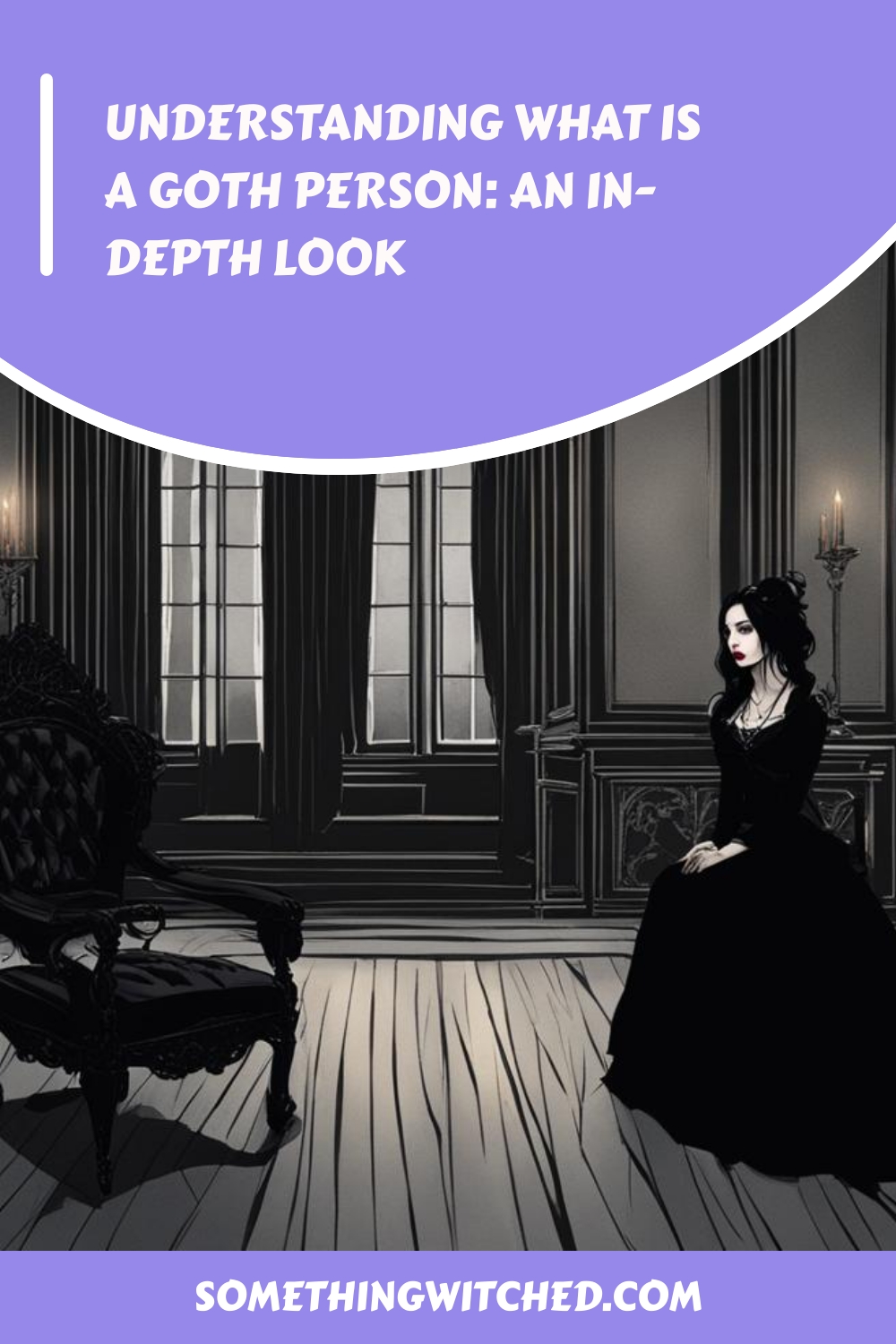Goths are often misunderstood and stereotyped, but they are much more than just their fashion choices. To truly understand what a goth person is, we need to delve into the depths of their subculture and explore the unique perspective they bring to the world.
A goth is someone who finds beauty in dark and mysterious things. They are not evil or unkind; rather, they have a different lens through which they view the world. Goths are often intelligent, romantic, and artistic realists. They see the beauty in darkness and are drawn to its allure.
Contrary to popular belief, goth is not just about fashion. It is a lifestyle and a subculture that emerged from the punk movement in the late 70s. While goth fashion is often associated with wearing black, it transcends color codes and embraces a wide variety of styles. Goths listen to a diverse range of music genres, from goth rock to electronic to classical. They can be found across the globe, coming from diverse backgrounds and ethnicities.
Key Takeaways:
- Goths find beauty in dark and mysterious things
- Goth is a lifestyle and a subculture
- Goth fashion is not limited to wearing black
- Goths listen to a wide variety of music genres
- Goths come from diverse backgrounds and ethnicities
The Beauty of the Dark: Goth Aesthetics
Goth fashion encompasses a unique and captivating aesthetic that embraces the darker side of beauty. It goes beyond the stereotypical all-black attire, drawing inspiration from multiple eras and cultures to create a diverse and intriguing style. Goth fashion is not limited to clothing; it is a form of self-expression and a celebration of individuality within the goth subculture.
In goth aesthetics, you’ll find a wide range of elements such as corsets, lace, leather, and unique, non-mainstream fashion choices. Goths appreciate the beauty found in darkness and use it to create sophisticated and edgy looks. The goth subculture allows individuals to explore their creativity and challenge societal norms by embracing unconventional fashion choices.
But goth aesthetics extend beyond clothing. Music, art, and literature also play a significant role in goth culture. Goths are drawn to the dark and moody themes reflected in these forms of expression. Through their fashion and artistic preferences, goths create a visual representation of their inner emotions and showcase their love for all things mysterious and hauntingly beautiful.
The Dark and Captivating World of Goth Aesthetics
“Goth fashion is not just about wearing black; it’s about embracing the beauty found in darkness.”
In summary, goth aesthetics are a fundamental part of the goth subculture. Goth fashion allows individuals to express their unique style and celebrate the allure of the dark. Through their fashion choices, goths create a visual representation of their inner emotions and showcase their love for all things mysterious and hauntingly beautiful.
Goth Music: A Hauntingly Beautiful Soundtrack to the Subculture
One of the defining features of the goth subculture is its unique and atmospheric music. Goth music emerged in the late 70s, evolving from the punk movement and embracing a darker, more introspective sound. It is characterized by its haunting melodies, melancholic lyrics, and brooding atmosphere. Goth music is diverse and encompasses various genres, from the iconic gothic rock to goth pop, neo-classical, and goth folk. It offers a rich and diverse soundscape that resonates with the goth community and captures the essence of their subculture.
The roots of gothic rock can be traced back to influential musicians and bands such as Marc Bolan, the Velvet Underground, David Bowie, and the Sex Pistols. However, many consider Nico’s album “The Marble Index” and Black Sabbath’s debut album as the first goth albums. These albums set the stage for the emergence of gothic rock as a genre with its atmospheric and introspective sound.
Goth music is not confined to a single style or sound. It draws inspiration from various musical influences, including post-punk, new wave, and classical music. This fusion of genres creates a unique and captivating sound that speaks to the depth of emotions and experiences within the goth subculture. Whether it’s the ethereal vocals of Siouxsie Sioux, the haunting melodies of The Cure, or the symphonic arrangements of Dead Can Dance, goth music offers a diverse range of sonic experiences for goth enthusiasts to immerse themselves in.
Goth music serves as a powerful soundtrack to the goth subculture, providing a means of expression, solace, and connection for its followers. It captures the beauty found in darkness, allowing goths to explore their emotions, embrace their individuality, and find a sense of belonging within the goth community. As goth music continues to evolve and inspire new generations of musicians, it remains a timeless and integral part of the goth subculture, resonating with its members and shaping their unique identity.
Embracing the Dark Side: Goth Fashion
Goth fashion, a key element of the goth subculture, allows individuals to express their unique style and embrace the beauty found in darkness. It goes beyond just clothing, encompassing accessories, makeup, and hairstyles that complete the goth look. The history of goth fashion dates back to the late 70s, emerging from the punk movement and drawing inspiration from various eras and cultures.
Goth fashion is not limited to a specific gender and can be enjoyed by anyone who finds it appealing. It draws inspiration from different eras and cultures, with influences from Victorian and Edwardian aesthetics. While black is often the dominant color in goth fashion, goths embrace a wide range of colors and textures. Corsets, lace, leather, and unique, non-mainstream fashion items are commonly incorporated into goth outfits.
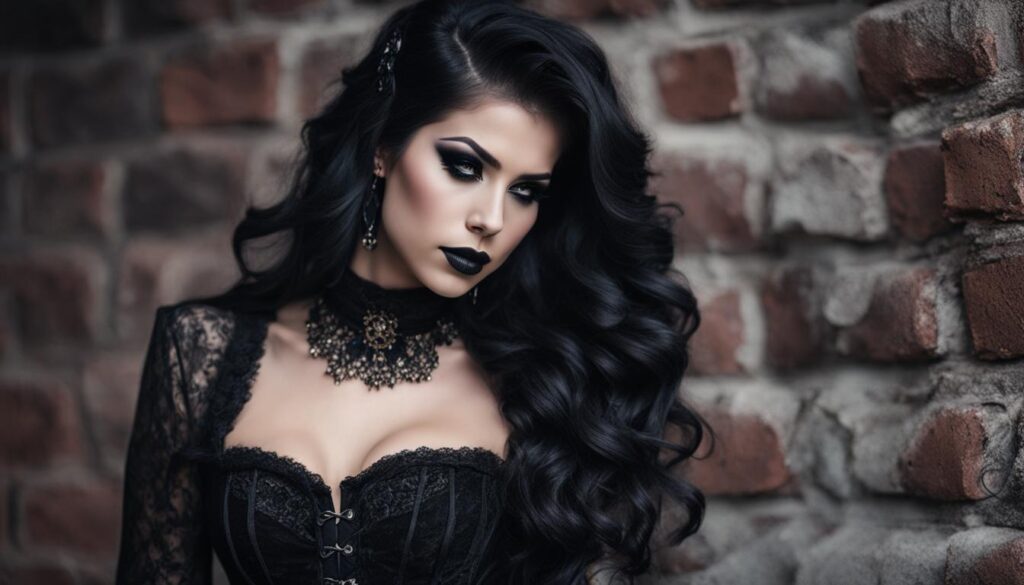
Goth fashion has evolved over the years but has always been a way for goths to express themselves and embrace their individuality. It is a reflection of their unique perspective and artistic sensibilities. By embracing the dark side of aesthetics, goths celebrate self-expression and the freedom to embrace the unconventional. Goth fashion is a testament to the fact that there is beauty to be found in the mysterious and the unconventional.
The Origins of Goth: A Historical Perspective
The goth subculture, with its unique aesthetics and symbolism, has a fascinating history that can be traced back to the late 60s and early 70s. However, the core elements of goth culture have existed in various forms throughout history, finding inspiration in literature, art, and music that explore dark and melancholic themes.
Figures such as Edgar Allan Poe, Charles Addams, and Edward Gorey have been associated with goth aesthetics and have influenced the subculture’s fascination with darkness and macabre beauty. The gothic literature of Poe and the morbid humor of Addams and Gorey have provided a foundation for the goth subculture’s love for the eerie and the mysterious.
“The goth subculture is a continuation of longstanding traditions, with its own unique expressions and interpretations of darkness.”
Goth symbolism can also be found in gothic architecture, with its dramatic arches, gargoyles, and imposing structures. The intricate and haunting beauty of gothic architecture has left an indelible mark on the goth subculture, inspiring its appreciation for grandeur and the macabre.
Overall, the goth subculture has evolved over time, but its roots can be found in the timeless fascination with darkness and the exploration of the beauty found within it. From literature to art to music, goths have embraced the darkness and created their own unique expressions of gothic aesthetics and symbolism.
Goth Subcultures: Exploring Diversity in Fashion and Music
The goth subculture is a diverse and vibrant community that embraces various subcultures within its overarching identity. These subcultures offer goths the opportunity to express themselves uniquely through fashion and music, creating a rich tapestry of styles and sounds. From pastel goth to trad goth, cyber goth to Victorian/romantic goth, each subculture brings its own distinctive aesthetic and music preferences to the goth community.

One of the fascinating aspects of goth subcultures is their ability to blend different elements and create new and innovative styles. Pastel goth, for example, combines the dark aesthetic of traditional goth with soft pastel colors, creating a striking contrast that captures attention. On the other hand, trad goth embraces the traditional gothic fashion of the 80s, with Victorian-inspired clothing and bold makeup, exuding a sense of darkness and allure. Cyber goth takes gothic fashion into the future, merging it with futuristic and cyberpunk aesthetics, resulting in a visually striking and edgy style.
Key Features of Goth Subcultures:
- Pastel Goth: Combines dark gothic aesthetics with soft pastel colors
- Trad Goth: Embraces the traditional gothic fashion of the 80s
- Cyber Goth: Blends gothic fashion with futuristic and cyberpunk elements
- Victorian/Romantic Goth: Draws inspiration from the elegance of the Victorian era
Music also plays a significant role in goth subcultures, with each subculture having its own preferred genres and bands. Pastel goths may enjoy upbeat and dreamy goth pop, while trad goths gravitate towards classic gothic rock bands like Bauhaus and Siouxsie and the Banshees. Cyber goths often appreciate electronic and industrial music, and Victorian/romantic goths may have an affinity for atmospheric neoclassical compositions. The diversity within goth subcultures extends beyond fashion and permeates the music choices of goths, adding yet another layer of richness to the community.
Through their distinctive styles and music preferences, goth subcultures create a sense of belonging and provide goths with a platform to express their individuality. Each subculture within the goth community offers a unique lens through which goths can explore their identity and embrace the beauty found in darkness. These subcultures illustrate the diverse nature of goth and highlight the vast possibilities for self-expression and creativity within the goth subculture.
Hate Crimes and the Goth Community: Recognizing Goth as a Culture
The goth community, like many other subcultures, has unfortunately been a target of hate crimes. These crimes, fueled by prejudice and ignorance, have shed light on the challenges faced by goths in society. One notable incident that brought attention to this issue was the tragic murder of Sophie Lancaster in 2007. Her brutal killing prompted the Greater Manchester Police to recognize attacks on goths, punks, emos, and metallers as hate crimes, acknowledging the alternative subculture identity.
Hate crimes against goths can encompass a range of offenses, including verbal abuse, physical assaults, vandalism, and discrimination. These acts of violence often stem from a lack of understanding and stereotypes associated with the goth subculture. It is crucial to recognize goth as a culture, just like any other, with its unique identity, values, and artistic expressions.
However, identifying goths and other subcultures for protection can be challenging. The goth community is diverse and ever-evolving, with individuals expressing their goth identity in various ways. Fluid and personal definitions of goth aesthetics, music preferences, and fashion choices make it difficult to establish a universal understanding of what it means to be goth. Nonetheless, it is essential to raise awareness about hate crimes against goths, advocate for their inclusion in hate crime legislation, and promote acceptance and understanding within society.
Exploring Different Types of Goth: Pastel Goth
Pastel goth is a subculture within the goth community that beautifully blends the dark aesthetic of traditional goth with the soft hues of pastel colors. It offers a unique and captivating style for those who are drawn to both dark and light aesthetics.
Pastel goth outfits often feature a mix of black and pastel clothing, creating a striking contrast that is visually appealing and eye-catching. The pastel goth aesthetic embraces pale shades of pink, blue, purple, and other pastel colors, along with gothic-inspired elements such as lace, corsets, and leather.
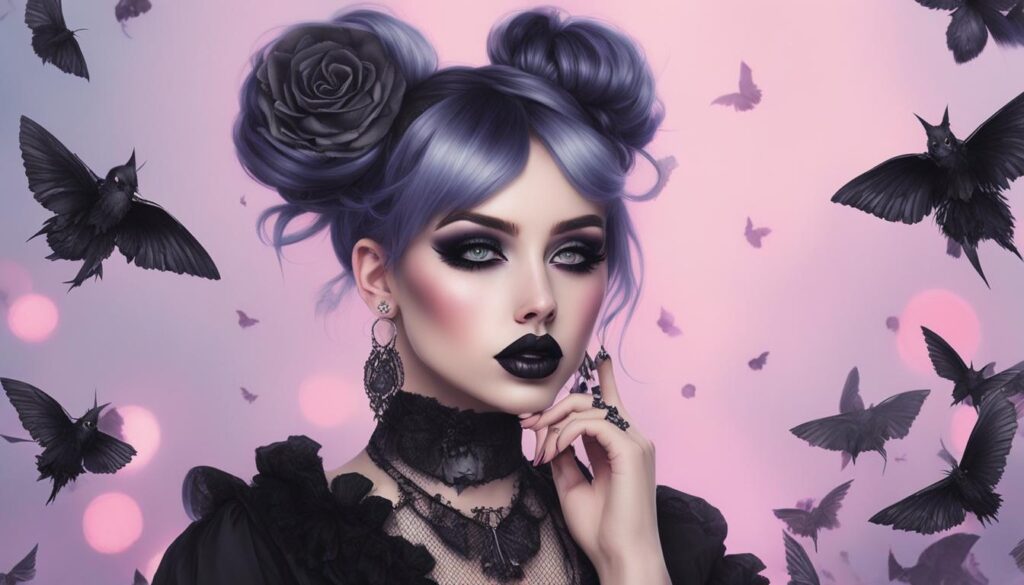
Embracing pastel goth allows individuals to express their creativity and unique sense of style within the goth subculture. It celebrates the beauty of contrasts, combining the darkness and mystery of traditional goth with the softness and delicacy of pastel colors. Pastel goth is not simply a fashion choice; it is a form of self-expression and a way to embrace the beauty found in darkness.
Pastel Goth Outfit Ideas:
- Black dress paired with pastel-colored accessories
- Pastel hair with dark makeup
- Pastel-colored fishnet stockings worn with black boots
- Pastel goth-inspired jewelry, such as chokers or rings
“Pastel goth allows individuals to embrace the darker side while adding a touch of softness and femininity.” – Goth Fashion Magazine
Exploring Different Types of Goth: Trad Goth
Trad goth, also known as traditional goth, is a subculture that embodies darkness, mystery, and allure. It draws inspiration from the origins of goth in the 80s and embraces a dark and brooding aesthetic. Trad goth fashion often includes elements of Victorian-inspired fashion, with an emphasis on black clothing, corsets, fishnets, and heavy boots. The trad goth look is completed with bold makeup, such as dark lipstick and heavy eyeliner, and a preference for vintage and gothic accessories. Trad goth is a celebration of individuality and self-expression within the goth subculture.
Trad Goth Outfits: Key Elements and Inspirations
When it comes to trad goth fashion, there are key elements and inspirations that define the look. These include:
- Victorian Influence: Trad goths often incorporate Victorian-inspired clothing and accessories into their outfits. This can include corsets, lace-up boots, and flowing garments.
- Dark Color Palette: Black is a staple in trad goth fashion, with goths opting for all-black ensembles. However, deep jewel tones like purple and red are also embraced.
- Bold Makeup: Trad goths are known for their dramatic makeup looks, often featuring heavy black eyeliner, dark lipstick, and pale foundation.
- Gothic Accessories: Trad goth outfits are often complemented by gothic accessories such as chokers, cameo brooches, and silver jewelry.
- Music and Culture: Trad goths are influenced by gothic music and literature, drawing inspiration from bands like Bauhaus and Sisters of Mercy, as well as gothic works of fiction.
Embracing the Trad Goth Aesthetic
Trad goth fashion is a way for individuals to embrace their love for darkness and mystery. It allows goths to express their unique style while paying homage to the origins of the goth subculture. Whether it’s the Victorian-inspired garments, bold makeup, or gothic accessories, trad goth outfits exude elegance and allure. By embracing the trad goth aesthetic, goths find a sense of belonging and create a visual representation of their inner selves within the goth community.
Exploring Different Types of Goth: Cyber Goth
Cyber goth is a subculture within the larger goth community that fuses gothic fashion with futuristic and cyberpunk aesthetics. It is characterized by a unique blend of dark clothing and neon or fluorescent accents, creating a striking contrast. The cyber goth aesthetic often incorporates elements of technology, such as LED lights, cyberlox, and cybernetic jewelry, adding an element of otherworldly allure to the look.
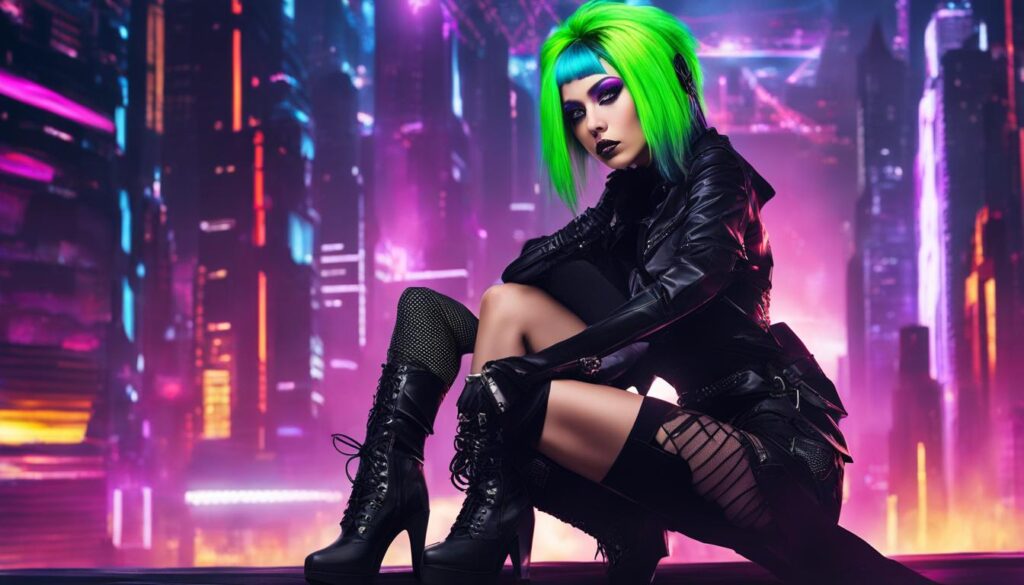
Cyber goths reject societal norms and embrace the underground, celebrating individuality and uniqueness. Their outfits often feature heavy makeup, particularly bold eye makeup, and hairstyles that defy gravity. The cyber goth subculture thrives on creativity and innovation, constantly pushing the boundaries of gothic fashion.
By blending darkness with a high-tech edge, cyber goths create a style that is modern and edgy, reflecting a futuristic vision of goth. Whether it’s through the use of vibrant colors or the incorporation of technological elements, cyber goth fashion allows individuals to express their own interpretation of goth in a way that is both captivating and visually striking.
Embracing the Dark Victorian Era: Victorian/Romantic Goth
The Victorian/Romantic Goth subculture draws inspiration from the aesthetics of the Victorian era, embracing the beauty found in darkness and adding a touch of romance to their fashion choices. This subculture celebrates the elegance, mystery, and allure of the Victorian era, incorporating elements such as long dresses, high collars, lace, and delicate details.
Victorian goth outfits often create a unique blend of gothic and Victorian styles, with a focus on black clothing and an emphasis on intricate lacework. Corsets, gloves, and cameo jewelry are commonly used to enhance the overall gothic look. By combining these Victorian-inspired elements with gothic accessories and dark makeup, Victorian goths create a mesmerizing and captivating presence.
The Victorian/Romantic Goth subculture embraces the idea that darkness and beauty can coexist, allowing goths to express themselves through an elegant and ethereal fashion statement. By embracing the dark Victorian era, these goths pay homage to the past while creating a sense of mystery and allure in the present.
The Soft Goth Aesthetic: Blending Darkness with Softness
Goth fashion has always been synonymous with dark and edgy aesthetics, but there is a subculture within the goth community that adds a touch of softness to the mix. Known as soft goth, this subculture combines the brooding elements of goth with a more delicate and feminine aesthetic.
In soft goth fashion, you’ll find a blend of black clothing and muted tones, along with gothic accessories such as lace, leather, and corsets. The soft goth aesthetic celebrates contrasts, juxtaposing darkness with pastel colors and delicate details. It’s a unique way for goths to express themselves and explore different facets of their identity within the goth subculture.
“Soft goth fashion embraces a more feminine and whimsical style, creating a contrast between darkness and softness.”
Soft goth outfits often feature flowing fabrics, ethereal silhouettes, and intricate details that evoke a sense of mystery and allure. It’s a style that allows individuals to embrace their dark side while also embracing their softer, more romantic side.
If you’re drawn to both the darkness and the ethereal, then the soft goth aesthetic might be the perfect fit for you. It’s a beautiful and captivating style that showcases the versatility and creativity within the goth subculture.
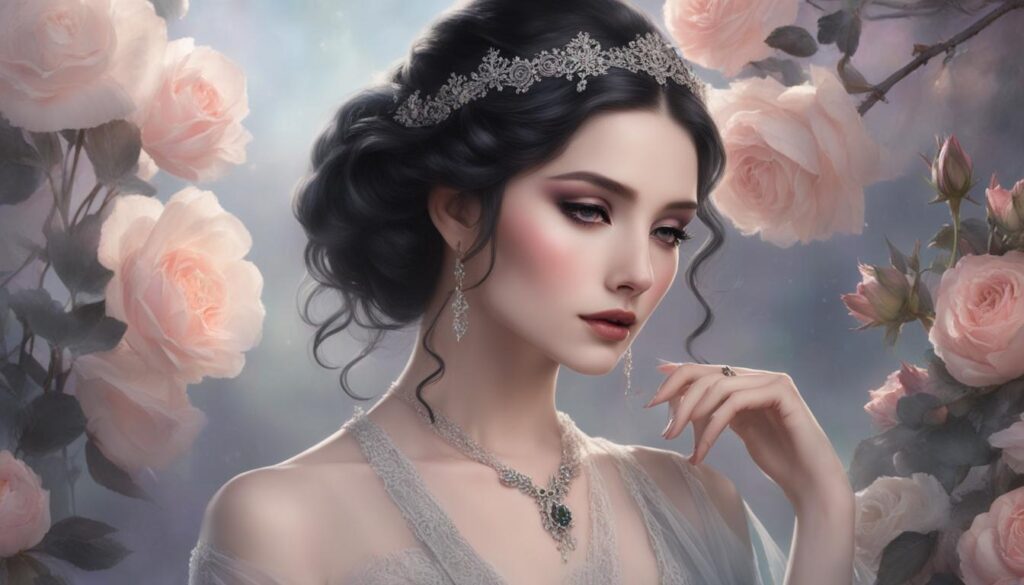
Key Features of Soft Goth Fashion:
- Contrasting dark and muted colors with pastel tones
- Lace, leather, and corset details
- Flowing fabrics and ethereal silhouettes
- Intricate and delicate accessories
Exploring Different Types of Goth: Hippie Goth
When it comes to goth fashion, there is a wide range of subcultures that offer unique and captivating styles for those who identify with the goth subculture. One such subculture is hippie goth. Hippie goth blends elements of gothic fashion with the free-spirited and nature-inspired aesthetics of the hippie movement. It celebrates the harmony between darkness and nature, creating an earthy and captivating style within the goth community.
Hippie goth outfits often feature flowing bohemian-style clothing, floral patterns, and natural fibers. The combination of dark colors with vibrant earth tones creates a striking and unique contrast. In addition to the clothing, goths who identify with the hippie goth subculture often incorporate gothic accessories and dark makeup into their look, further emphasizing their connection to the goth subculture.
The hippie goth aesthetic is all about embracing individuality and expressing oneself authentically. By blending elements of goth fashion with the free-spiritedness of the hippie movement, hippie goths create a captivating and unique style that allows them to stand out while embracing their connection to nature and darkness.
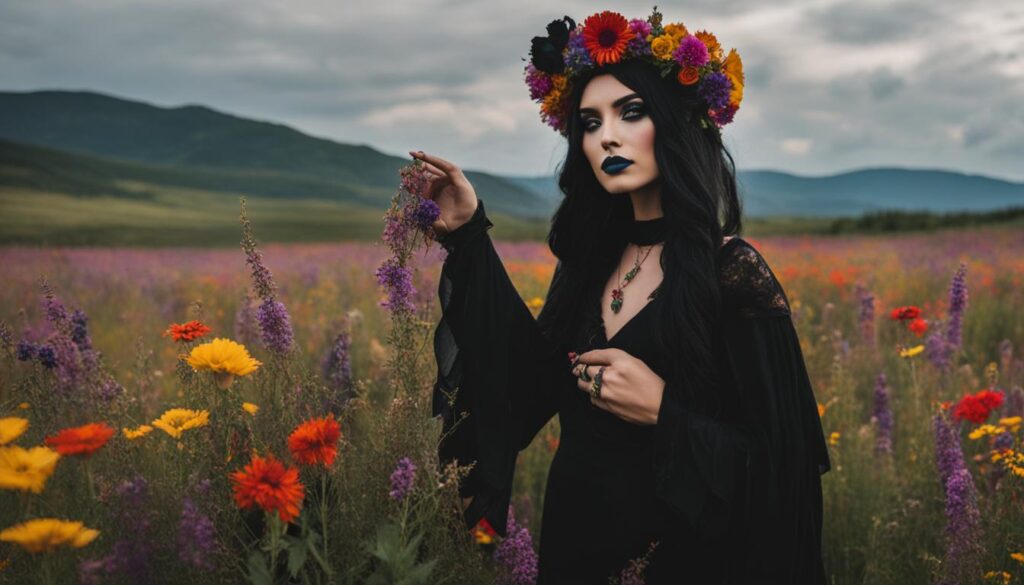
Key Elements of Hippie Goth Fashion:
- Flowing bohemian-style clothing
- Floral patterns and natural fibers
- Dark colors combined with earth tones
- Gothic accessories
- Dark makeup
Hippie goth is a celebration of the connection between darkness and nature, blending elements of gothic fashion with the free-spiritedness of the hippie movement. It offers a unique and earthy style within the goth subculture, allowing individuals to express their connection to both darkness and the natural world.
Lolita Goth: Celebrating Elegance and Innocence
Lolita goth is a subculture within the goth community that draws inspiration from the elegant and innocent fashion of the Victorian and Rococo eras. It combines the dark elements of goth with the frilly dresses, petticoats, bows, and lace characteristic of the Lolita style. This unique blend creates a whimsical and enchanting aesthetic that celebrates femininity and a childlike innocence.
Lolita goth outfits often feature a variety of dresses in dark or muted colors, adorned with delicate lace trimmings, intricate bows, and voluminous petticoats. The attention to detail and emphasis on modesty create a distinct and refined look that stands out within the goth subculture.
“Lolita goths create a unique and whimsical style within the goth subculture, combining elegance with a touch of darkness.”
Accessories play a crucial role in completing the Lolita goth look. Elaborate headpieces, lace gloves, parasols, and Victorian-inspired footwear are commonly seen in Lolita goth fashion. The attention to accessorizing allows individuals to express their creativity and further enhance the overall aesthetic.
Lolita goth is a celebration of elegance, innocence, and self-expression within the goth subculture. It offers a unique way for individuals to embrace their love for both darkness and beauty, creating a captivating and enchanting style that sets them apart.
Modern and Edgy: Nu Goth
The nu goth subculture, a modern take on goth fashion, emerged in the 2010s and has gained popularity among alternative fashion enthusiasts. Combining elements of traditional goth with contemporary and edgy aesthetics, nu goth brings a fresh and innovative twist to the goth subculture.
Nu goth outfits often feature a blend of black clothing, minimalistic shapes, and geometric patterns. The style embraces a more urban and streetwear-inspired look, incorporating elements from various alternative fashion trends.
With its cutting-edge aesthetic, nu goth allows individuals to express their unique style within the goth subculture. It provides a platform to reimagine goth fashion for the modern age, pushing boundaries and embracing the edginess of the present.
Whether it’s through dark and minimalistic attire or bold and graphic ensembles, nu goth offers a contemporary and captivating style for those seeking a modern and edgy take on goth fashion.
FAQ
What is a goth person?
A goth is someone who finds beauty in dark and mysterious things. They are not evil or unkind, but rather have a different perspective and are often intelligent, romantic, and artistic realists.
Is goth just about fashion?
No, goth is not just about fashion. It is a lifestyle and a subculture that emerged from the punk movement in the late 70s. Goth fashion is just one aspect of the goth subculture.
What colors do goths wear?
Goth fashion does not have a color code. Goths can wear a wide variety of colors, although black is often associated with goth fashion. The choice of color is subjective and personal to each individual goth.
What kind of music do goths listen to?
Goths listen to a wide variety of music genres. While gothic rock is often associated with goth subculture, goths can also enjoy other genres such as post-punk, darkwave, industrial, and more.
Who can be a goth?
Goths can come from diverse backgrounds and ethnicities. It is not limited to a specific gender or age group. Anyone who resonates with goth aesthetics and identifies as a goth can be a part of the goth subculture.
What are the main elements of goth fashion?
Goth fashion embraces the darker side of aesthetics and incorporates elements such as corsets, lace, leather, and unique, non-mainstream fashion. It draws inspiration from multiple eras and cultures, resulting in a diverse and individualistic style.
How did goth music originate?
Goth music emerged in the late 70s and was influenced by artists such as Marc Bolan, the Velvet Underground, and David Bowie. Black Sabbath’s debut album is also regarded as one of the first goth-rock records. Goth music spans various genres and offers a diverse range of sounds for goth enthusiasts.
Can anyone enjoy goth fashion?
Yes, goth fashion is not limited to a specific gender. Anyone who finds it appealing can enjoy and embrace goth fashion. It is a form of self-expression and personal style.
What is the history of goth subculture?
The goth subculture has roots that can be traced back to the late 60s and early 70s. Figures such as Edgar Allan Poe and Charles Addams have been associated with goth aesthetics. The goth subculture is a continuation of these longstanding traditions, with its own unique expressions and interpretations of darkness.
Are there different types of goth?
Yes, the goth subculture encompasses various subcultures and styles within its overarching identity. Some notable goth subcultures include pastel goth, trad goth, cyber goth, victorian/romantic goth, soft goth, hippie goth, lolita goth, nu goth, perky goth, and vampire goth.
What is pastel goth?
Pastel goth is a subculture that combines the dark aesthetic of traditional goth with the soft hues of pastel colors. It embraces pale shades of pink, blue, purple, and other pastel colors, along with gothic-inspired elements such as lace, corsets, and leather.
What is trad goth?
Trad goth, also known as traditional goth, is a subculture that embodies darkness, mystery, and allure. It draws inspiration from the origins of goth in the 80s and embraces a dark and brooding aesthetic with elements of Victorian-inspired fashion.
What is cyber goth?
Cyber goth is a subculture that blends gothic fashion with futuristic and cyberpunk aesthetics. It features dark clothing with neon or fluorescent accents and incorporates elements of technology, such as LED lights and cybernetic jewelry.
What is victorian/romantic goth?
Victorian/romantic goth is a subculture that draws inspiration from the aesthetics of the Victorian era. It embraces the dark and romantic elements of Victorian fashion, featuring long dresses, high collars, lace, and delicate details.
What is soft goth?
Soft goth is a subculture that combines the dark and brooding elements of goth with a softer and more delicate aesthetic. It often features pastel colors or muted tones, along with traditional goth elements such as black clothing, lace, and leather.
What is hippie goth?
Hippie goth blends elements of gothic fashion with the free-spirited and nature-inspired aesthetics of the hippie movement. It often features flowing bohemian-style clothing, floral patterns, and natural fibers, combined with gothic accessories and dark makeup.
What is lolita goth?
Lolita goth draws inspiration from the elegant and innocent fashion of the Victorian and Rococo eras. It features frilly dresses, petticoats, bows, and lace, often in dark or muted colors, while celebrating femininity and a childlike innocence.
What is nu goth?
Nu goth is a subculture that emerged in the 2010s and combines elements of traditional goth with modern and edgy aesthetics. It often features a blend of black clothing, minimalistic shapes, and geometric patterns, incorporating elements from streetwear and alternative fashion.
